Introduction
This post focuses on the creation, configuration and tuning of an initial SOA Suite 12.2.1.1.0 Domain.
The WebLogic Server is a necessary requirement, and must already be installed. For instruction how to install the WebLogic Server 12.2.1.1 please refer to my previous post: WebLogic Server 12.2.1.1.0: Installation on the Linux OS
The following tasks will be implemented:
- Preparing the Operating System for the installation of the WebLogic Server 12.2.1.1, Installation JDK 1.8 and the WebLogic Server 12.2.1.1: WebLogic Server 12.2.1.1.0: Installation on the Linux OS
- Creating of database schemas
- Creating a SOA Suite Domain
-
Post-Installation Tasks:
- Configuring of components
- Creating of Start & Stop scripts for the automatic start/stop of components
- SOA Suite Domain Tuning and Troubleshooting
The SOA/OSB Domain will be installed without BAM (different Domain) because of:
– Oracle Best Practices and our experience
– In order to stabilize the system (BAM is unstable at the moment)
The Domain will be created on two servers (OS OEL 6.7):
- host01.example.com
- host02.example.com
We will configure four clusters:
- OWSM Cluster (Oracle Web Services Management)
- ESS Cluster (Enterprise Scheduler Services)
- SOA Cluster
- OSB Cluster (Oracle Service Bus)
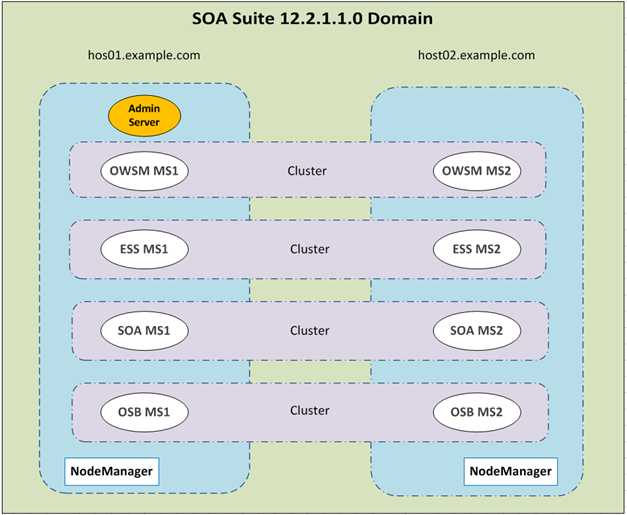
Installation SOA / OSB 12.2.1.1
Note: All tasks described in this chapter must be running on both servers: host01 and host02
Prepare Software
Download and extract the following software from the Oracle Software Delivery Cloud: https://edelivery.oracle.com:
– SOA Suite 12.2.1.1.0

– OSB 12.2.1.1.0

Installation SOA Suite 12.2.1.1 (as OS User oracle)
Note: All tasks described in this chapter must be running on both servers: host01 and host02
Navigate to software directory, extract the SOA software, set the environment and start the installation:
[oracle@host01 Oracle_Home]$ cd /u01/app/oracle/software/SOA_Suite/ [oracle@host01 SOA_Suite]$ unzip V138472-01.zip [oracle@host01 SOA_Suite]$ export JAVA_HOME=/u01/app/oracle/product/JAVA/jdk [oracle@host01 SOA_Suite]$ export PATH=$JAVA_HOME/bin:$PATH [oracle@soa01 SOA_Suite]$ java -jar ./fmw_12.2.1.1.0_soa.jar
On the Welcome page click „Next“:
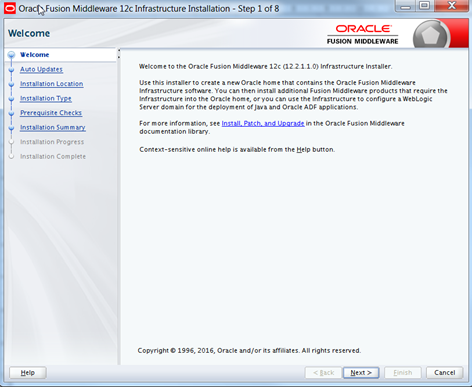
Enable „Skip Auto Updates“:
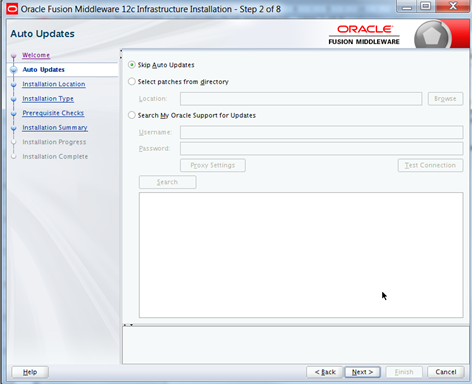
Set the Oracle Home to /u01/app/oracle/product/FMW/Oracle_Home:
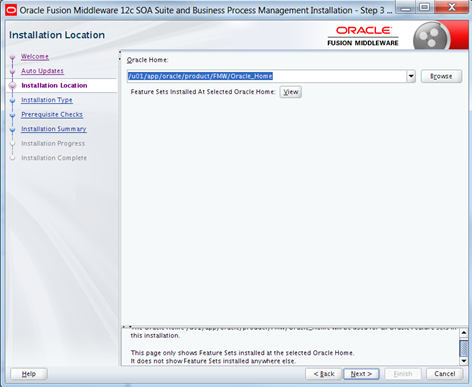
Activate „Fusion Middleware Infrastructure“:
Activate „SOA Suite“:
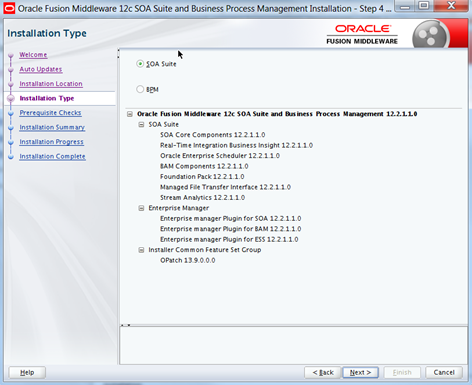
Prerequisite Checks:
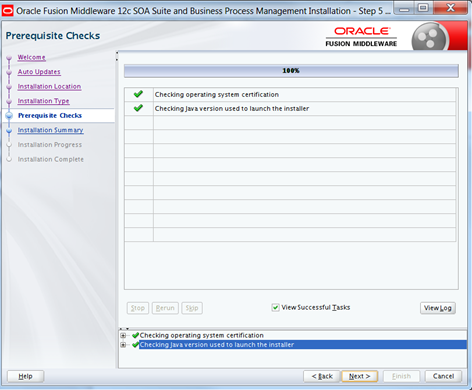
Verify the Summary of the Installation and click the button „Install“:
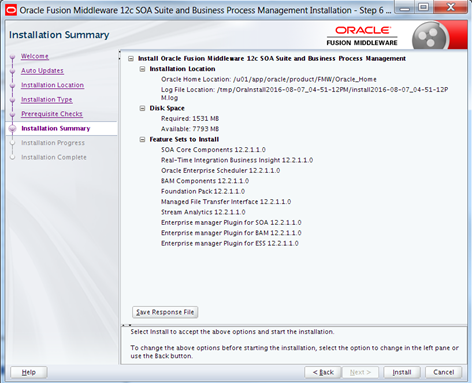
Verify installation“¦Next:
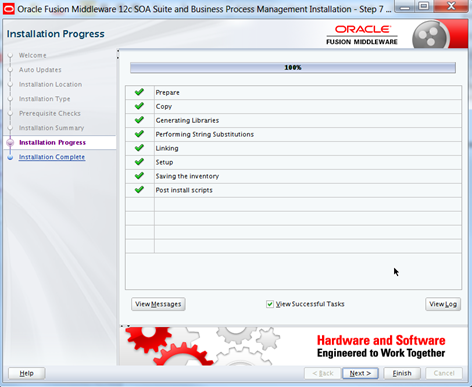
Check installed components and click „Finisch“:
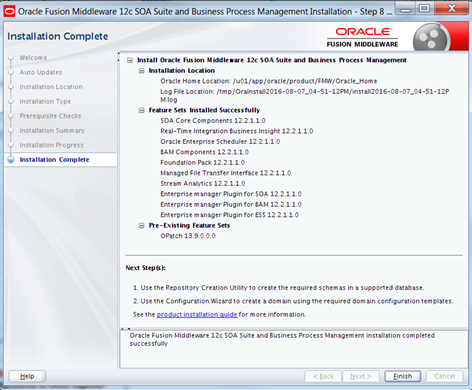
The Installation Oracle SOA Suite 12.2.1.1.0 is now completed
Installation Oracle Service Bus 12.2.1.1 (as OS User oracle)
Note: All tasks described in this chapter must be running on both servers: host01 and host02
[oracle@host01 SOA_Suite]$ cd /u01/app/oracle/software/OSB/ [oracle@host01 OSB]$ unzip V138477-01.zip [oracle@host01 OSB]$ export JAVA_HOME=/u01/app/oracle/product/JAVA/jdk [oracle@host01 OSB]$ export PATH=$JAVA_HOME/bin:$PATH [oracle@host01 OSB]$ java -jar ./fmw_12.2.1.1.0_osb.jar
On the Welcome page click „Next“:
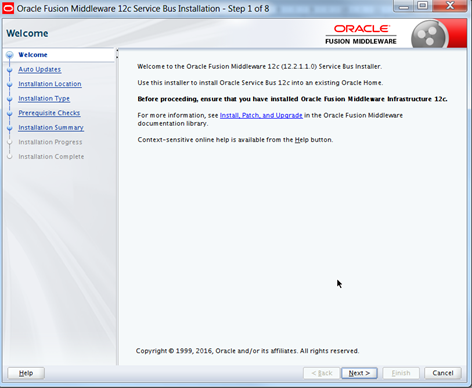
Enable „Skip Auto Updates“:
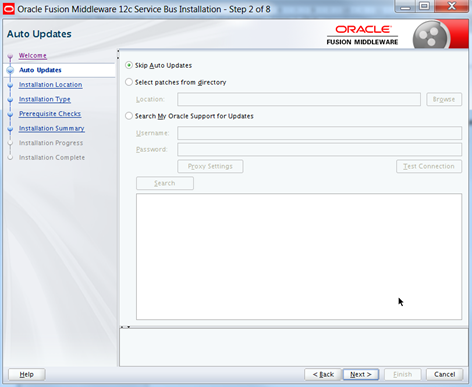
Set the Oracle Home to /u01/app/oracle/product/FMW/Oracle_Home:
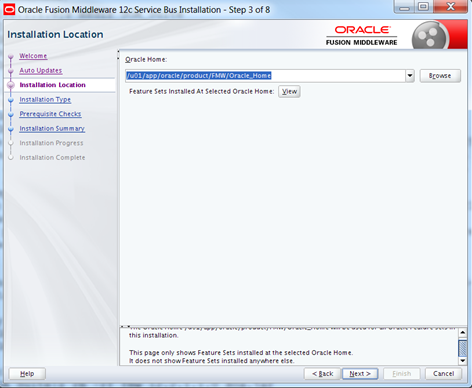
Activate the button „Service Bus“:
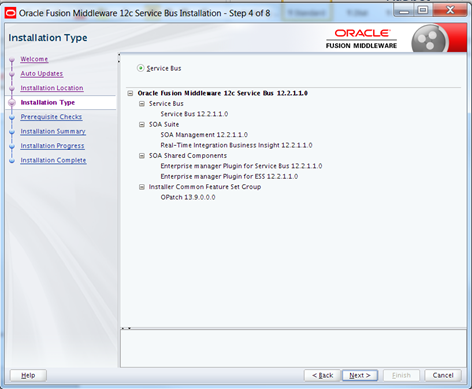
Prerequisite Checks:
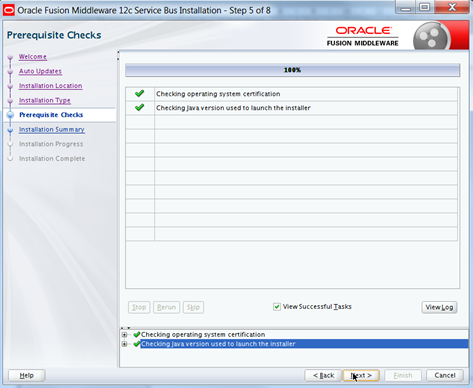
Verify the Summary of the Installation and click the button „Install“:
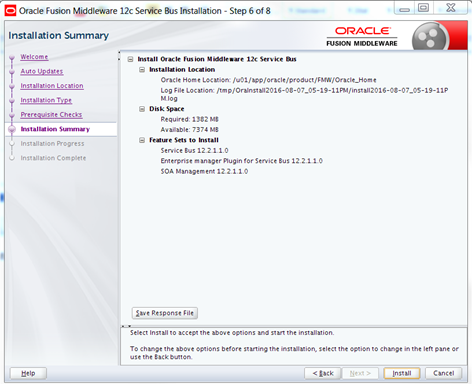
Verify installation“¦Next:
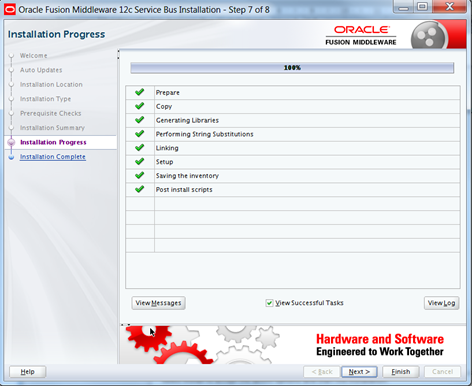
Check installed components and click „Finish“:
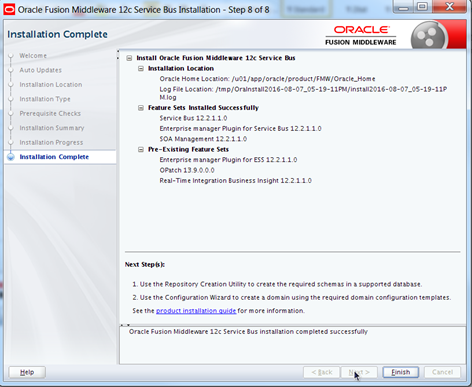
The Installation Oracle Servce Bus 12.2.1.1.0 is now completed
Create Database Schemas (as OS User oracle)
Note: The creating of the database schemas must be running only once on the first server: host01
The database must be already created and prepared for the WebLogic Server Domain. For more information about the preparing the database please refer to the documentation:
http://docs.oracle.com/html/E73100_01/toc.htm#GUID-85F0EAF9-3ACE-421D-BD72-F1A8E6B91116
Login to the server as user oracle, navigate to oracle_common directory, and start the Repository Creation Utility (RCU):
[oracle@host01 oracle]$ cd /u01/app/oracle/product/FMW/Oracle_Home/oracle_common/bin [oracle@host01 bin]$ ./rcu
Step 1: the Welcome page: click „Next“:
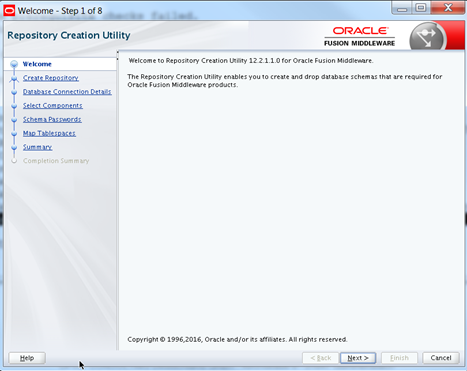
Step 2: Create Repository: For the new SOA Installation choose „Create Repository“ and „System Load and Production Load“:
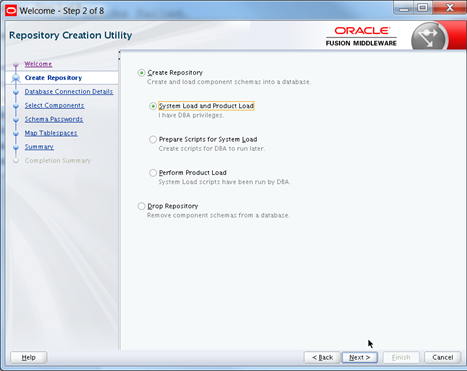
Step 3: Database Connection Details: On this Page provide the database connection information:
Database Type: Oracle Database
Host Name (database host): host02.example.com
Port (Database Listener Port: 1521)
Service Name (Service Name of the repository database): orcl
Username & Password: Administration Account of the SOA Database: sys/xxx
Role (Database Admin Role: SYSDBA or SYSOPER): SYSDBA
„¦ „Next“:
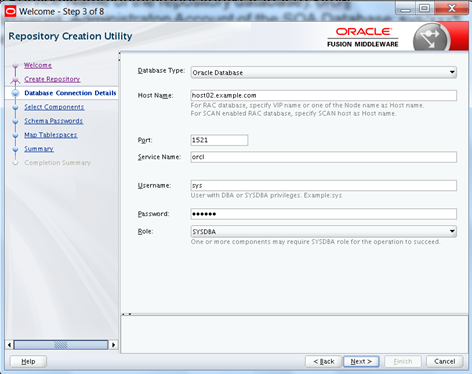
The Installer checks the database connectivity:
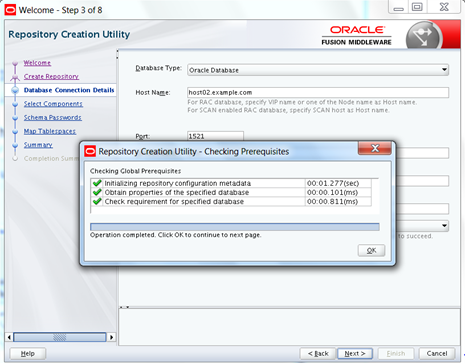
Step 4: Select Components and the Prefix for database schemas:
Following are mandatory selected components:
- Common Infrastructure Services (Mandatory selected components cannot be deselected)
Additionally I selected „Oracle Platform Security Services“, „SOA Infrastructure“ and „Oracle Enterprise Scheduler“.
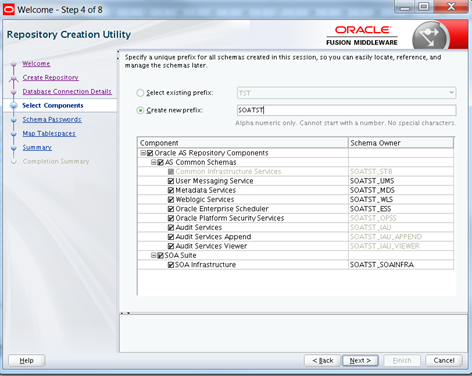
The installer will check database prerequisites:
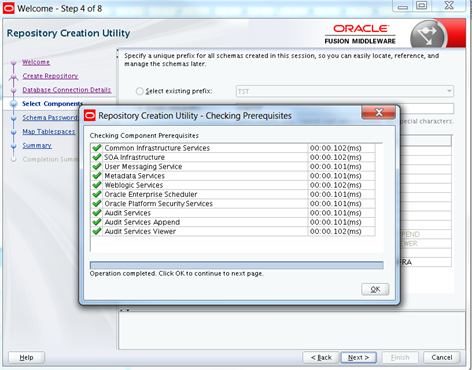
Step 5: Set the password for all database schemas:
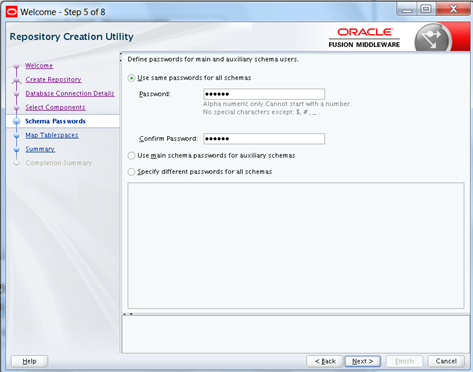
Step 6: Choose the size of the SOA Repository (small, medium or high): Medium
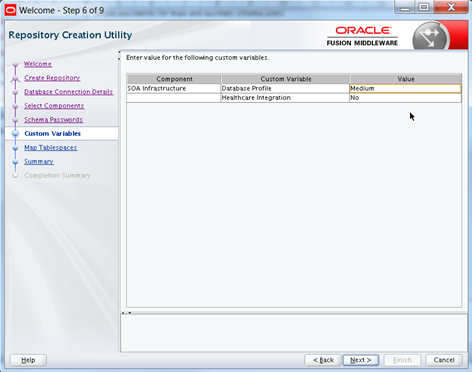
Step 7: Map Tablespaces: On this page you can change the tablespace settings:
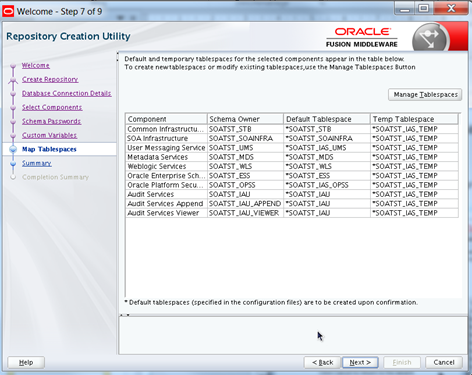
In the next step the installer asks for the creating tablespaces for the soa repository:
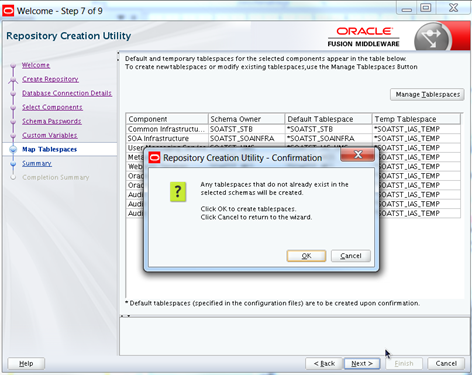
Tablespaces will be created:
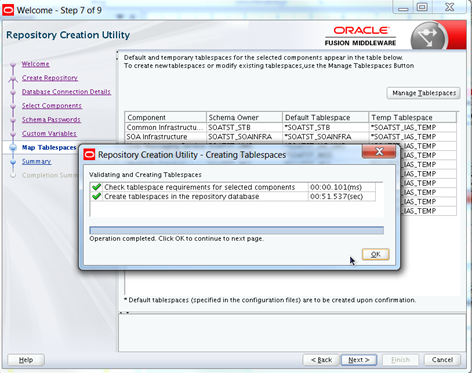
Step 8: Summary: check the details and click „Create“:
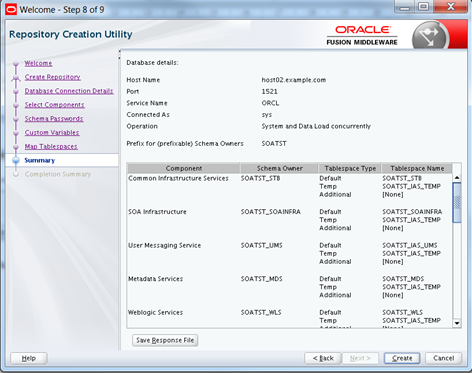
Check detail and click „Close“:
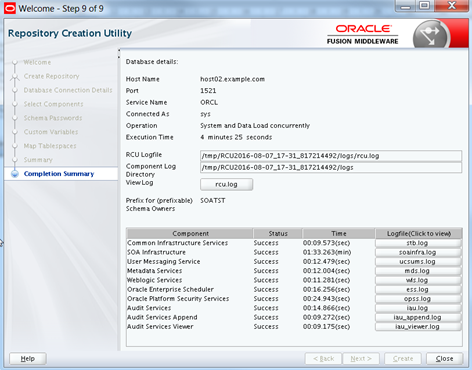
The SOA Repository Creation is now completed
Create the SOA / OSB Domain (as OS User oracle)
Note: The creating of the WebLogic Server Domain must be running only once on the first server: host01.
Navigate to the oracle_common directory and start the Configuration Wizard:
[oracle@host01 bin]$ cd /u01/app/oracle/product/FMW/Oracle_Home/oracle_common/common/bin [oracle@host01 bin]$ ./config.sh
Choose „Create a new Domain“ and set the „Domain Location“ to /u01/app/oracle/user_projects/domains/soa_domain:
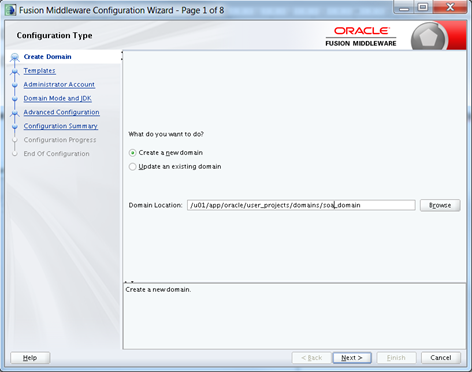
On the next page you can add several WebLogic Server and SOA „“ OSB Templates.
Select „SOA Suite“, „Oracle Service Bus“, „Oracle API Manager“, „Oracle Enterprise Scheduler Service Basic“, „Oracle User Messaging Service Basic“ and „Oracle OPSS REST Service Application“ (additional prerequisite components Coherence and JRF will be selected automatically).
For more information about templates please refer to oracle documentation:
https://docs.oracle.com/middleware/1221/wls/WLDTR/fmw_templates.htm#WLDTR227
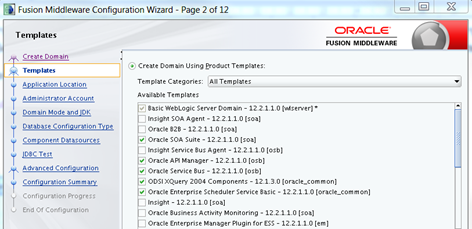

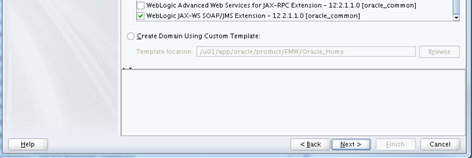
Specify an „Application Location“: /u01/app/oracle/user_projects/applications/soa_domain:
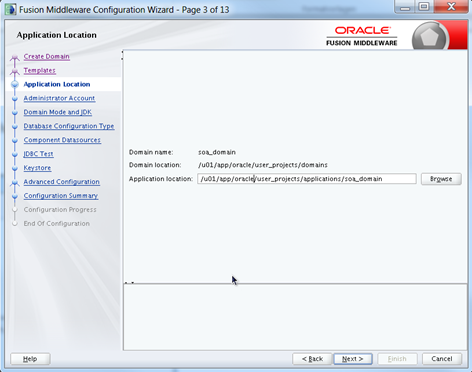
Set the Name and Password for the WebLogic Administrator:
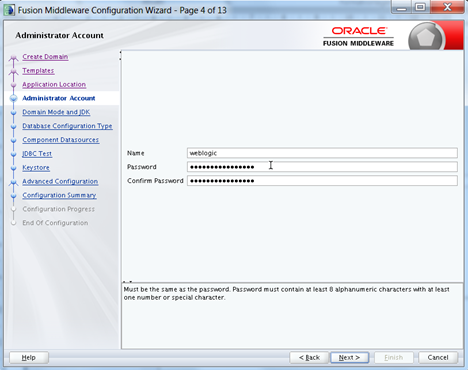
Choose „Domain Mode“: Production and check the JDK location:
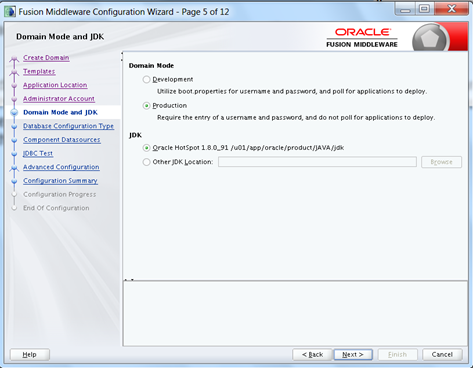
Configure the database details:
Specify the correct schema prefix: SOATST_STB and the information what were specified when you previously ran RCU (Chapter „Create Database Schemas“).
Then click on the Button „Get RCU Configuration“:
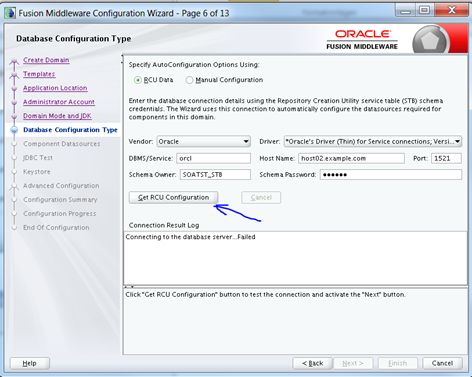
Installer checks database connectivity“¦ „Next“:
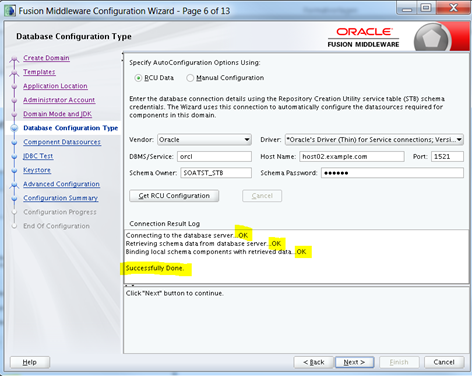
Let default values and click „Next“:
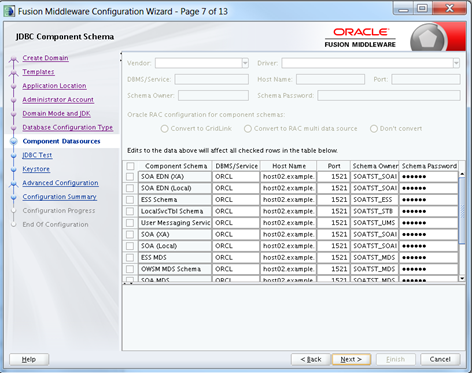
The installer checks the database connections:
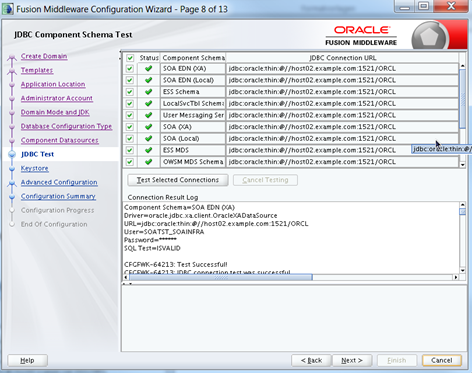
We don’t configure the Key Store. Let default values and click „Next“
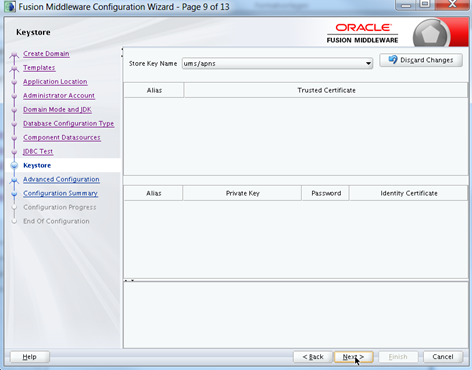
Activate check boxes for Administration Server, Node Manager and Topology for the advanced configuration:
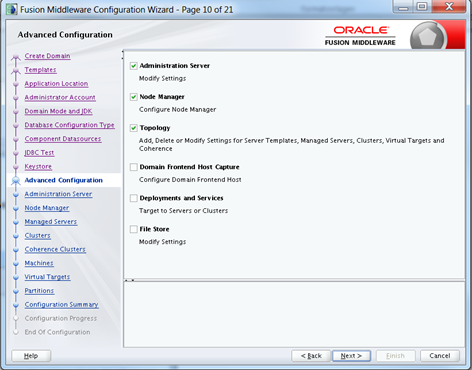
On the next page configure the Administration Server:
Name: AdminServer
Listen Address: 192.168.75.32 (IP Address Server host01.example.com)
Listen Port: 7001
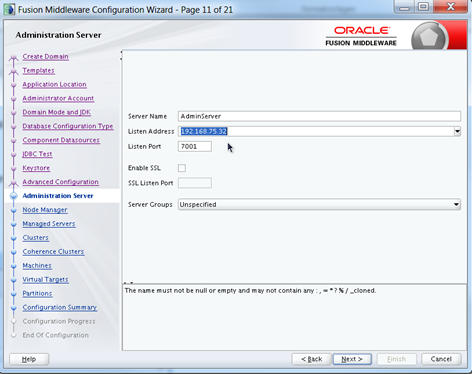
Configure the Node Manager:
Set Node Manager Type to „Per Domain Default Location“ „“ default
Enter Node Manager Credentials:
Username: nodemanager
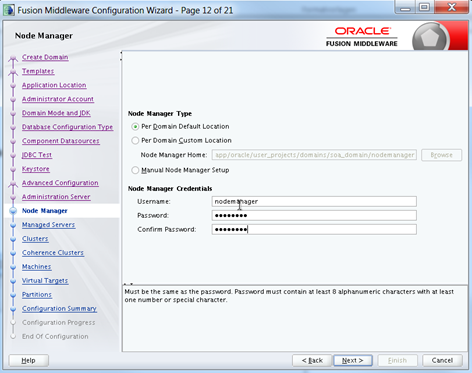
On the page „Managed Servers“ add 8 Managed Servers with following settings:
| Managed server | Listen Address | Port | Server Group |
| soa_server1 | 192.168.75.32 | 7003 | SOA-MGD- SVRS-ONLY |
| osb_server1 | 192.168.75.32 | 7004 | OSB-MGD-SVRS-ONLY |
| ess_server1 | 192.168.75.32 | 7005 | ESS-MGD-SVRS |
| owsm_server1 | 192.168.75.32 | 7006 | JRF-MAN-SVR, WSM-CACHE-SVR, WSMPM-MAN-SVR |
| soa_server2 | 192.168.75.33 | 7003 | SOA-MGD- SVRS-ONLY |
| osb_server2 | 192.168.75.33 | 7004 | OSB-MGD-SVRS-ONLY |
| ess_server2 | 192.168.75.33 | 7005 | ESS-MGD-SVRS |
| owsm_server2 | 192.168.75.33 | 7006 | JRF-MAN-SVR, WSM-CACHE-SVR, WSMPM-MAN-SVR |
In this example we will create eight managed servers for soa, osb, scheduler and webservices.
We will place the four managed server (soa_server1, osb_server1, ess_server1 and owsm_server1) on the server host01.example.com (IP Address: 192.168.75.32) and the four managed server (soa_server2, osb_server2, ess_server2 and owsm_server2) on the host02.example.com (IP Address: 192.168.75.32).
Server groups in the Middleware 12c allow to target and execute of middleware components (such soa or osb) on managed servers.
For example the server group SOA-MGD-sRVC-ONLY is responsible to execute the SOA content.
Server groups JRF-MAN-SVR and WSM-CACHE-SVR / WSMPM-MAN-SRV ensure that Oracle JRF and Oracle Web Services Manager (OWSM) services target Managed Servers you are creating.
For more info about Server Groups please refer to: https://docs.oracle.com/middleware/1221/core/INFIN/GUID-CA80A6E9-8903-4E19-81D7-A3647A11D0A6.htm#INFIN332
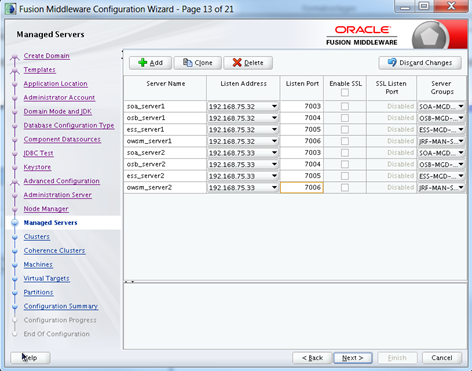
Create 4 Clusters: soa_cluster1, osb_cluster1, ess_cluster1 and owsm_cluster1.
Leave all another fields default „¦ „Next“:
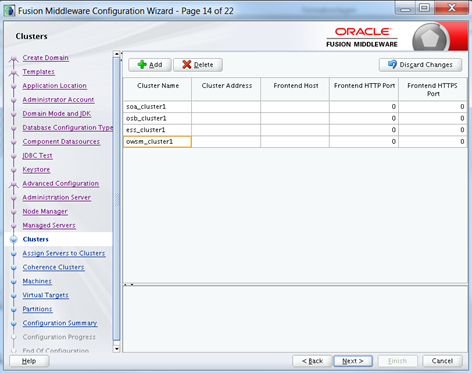
Add Managed Servers to clusters:
ess_cluster1: ess_server1, ess_server2
osb_cluster1: osb_server1, osb_server2
owsm_cluster1: owsm_server1, owsm_server2
soa_cluster1: soa_server1, soa_server2
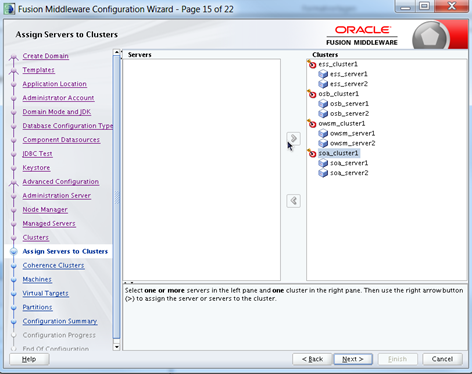
Specify the Coherence Cluster Listen Port:
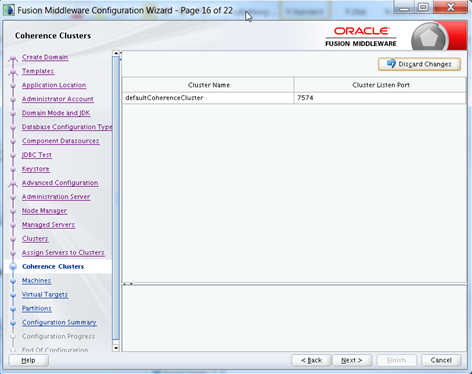
Create two Unix Machines: one for the host host01.example.com and the second UNIX Machine for the host02.example.com):
| Name | Listen Address | Port |
| host01.example.com | 192.168.75.32 | 5556 |
| host02.example.com | 192.168.75.33 | 5556 |
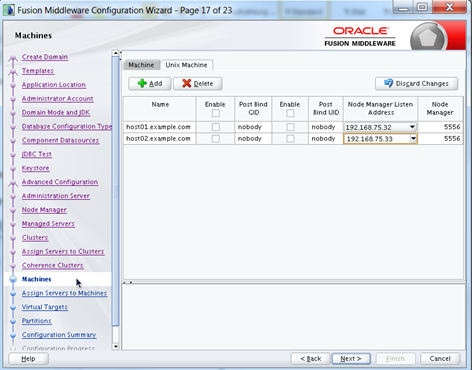
Add Managed Servers to machines:
host01.example.com: AdminServer, ess_server1, osb_server1, owsm_server1, soa_server1
host01.example.com: ess_server2, osb_server2, owsm_server2, soa_server3
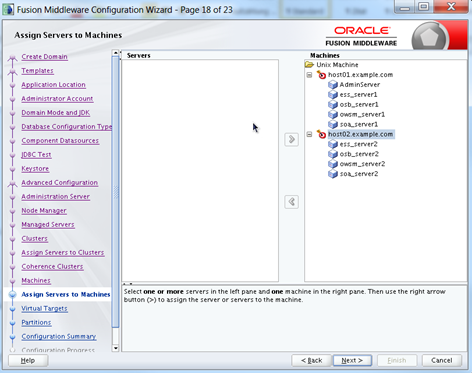
In this example we don’t configure „Virtual Targets“:
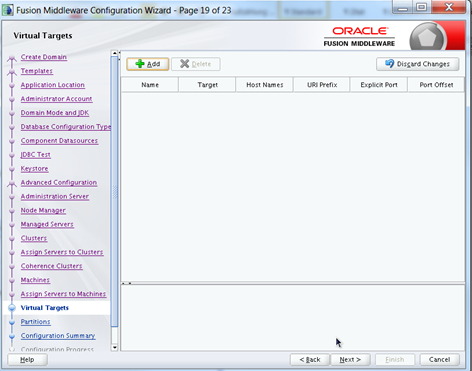
We don’t create „Partitions“:
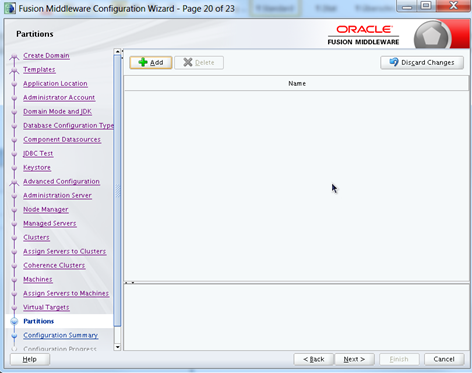
Check configuration summary and press the button „Create“:
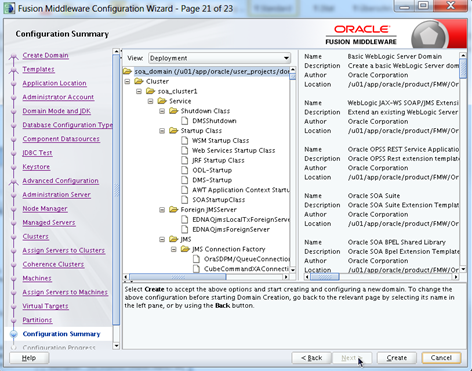
The Creation of initial Domain is now completed“¦ „Next“
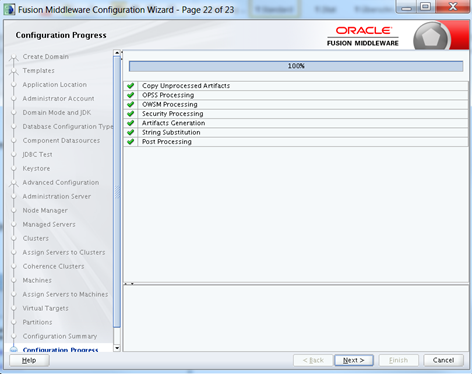
The SOA Domain is now created, „¦“Finish“:
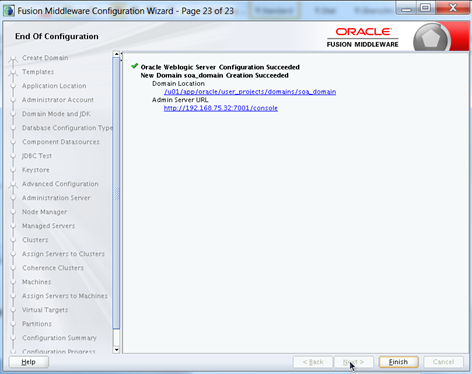
Post-Installation Tasks
Disabling the Derby Database
Note: All tasks described in this chapter must be running on both servers: host01.example.com and host02.example.com
[oracle@host01]$ cd /u01/app/oracle/product/FMW/Oracle_Home/wlserver/common/derby/lib/ [oracle@host01 lib]$ mv derby.jar disable_derby.jar
Start the AdminServer via script
Enter the values for the Administration User (weblogic) and passwort when prompted:
[oracle@host01 bin]$ cd /u01/app/oracle/user_projects/domains/soa_domain/bin [oracle@soa01 bin]$ ./startWebLogic.sh Enter username to boot WebLogic server:weblogic Enter password to boot WebLogic server:xxx
Shutdown the AdminServer via script:
[oracle@host01 bin]$ cd /u01/app/oracle/user_projects/domains/soa_domain/bin [oracle@soa01 bin]$ ./stopWebLogic.sh
Create the file boot.properties on the server host01
[oracle@host01]$ cd /u01/app/oracle/user_projects/domains/soa_domain/servers/AdminServer [oracle@host01 AdminServer]$ mkdir security [oracle@host01 AdminServer]$ cd security/ [oracle@host01 security]$ echo -e "username=weblogic\npassword=welcome1" > boot.properties [oracle@host01 security]$ cat boot.properties username=weblogic password=welcome1
Copying the Domain configuration from the server host01 to the host02
Save the Domain configuration on the server host01:
[oracle@host01 oracle]$ cd /u01/app/oracle/product/FMW/Oracle_Home/oracle_common/common/bin [oracle@host01 bin]$ ./pack.sh -domain=/u01/app/oracle/user_projects/domains/soa_domain -template=/home/oracle/soa_domain.jar -template_name=soa_domain
Output:
<< read domain from "/u01/app/oracle/user_projects/domains/soa_domain" >> succeed: read domain from "/u01/app/oracle/user_projects/domains/soa_domain" << write template to "/home/oracle/soa_domain.jar" .............................. >> succeed: write template to "/home/oracle/soa_domain.jar" << close template >> succeed: close template
Copy the file host01:/home/oracle/soa_domain.jar to the server host02
[oracle@host01 ~]$ scp /home/oracle/soa_domain.jar host02.example.com:/home/oracle
Extract the domain configuration on the server host02.example.com:
[oracle@host02 oracle]$ mkdir -p /u01/app/oracle/user_projects/domains [oracle@host02 oracle]$ mkdir -p /u01/app/oracle/user_projects/applications [oracle@host02 oracle]$ cd /u01/app/oracle/product/FMW/Oracle_Home/oracle_common/common/bin [oracle@host02 bin]$ ./unpack.sh -user_name=weblogic -password=welcome1 -domain=/u01/app/oracle/user_projects/domains/soa_domain -overwrite_domain=true -template=/home/oracle/soa_domain.jar -log_priority=DEBUG -log=/tmp/unpack.log -app_dir=/u01/app/oracle/user_projects/applications
Output:
<< read template from "/home/oracle/soa_domain.jar" >> succeed: read template from "/home/oracle/soa_domain.jar" << set config option AppDir to "/u01/app/oracle/user_projects/applications" >> succeed: set config option AppDir to "/u01/app/oracle/user_projects/applications" << find User "weblogic" as u1_CREATE_IF_NOT_EXIST >> succeed: find User "weblogic" as u1_CREATE_IF_NOT_EXIST << set u1_CREATE_IF_NOT_EXIST attribute Password to "********" >> succeed: set u1_CREATE_IF_NOT_EXIST attribute Password to "********" << set u1_CREATE_IF_NOT_EXIST attribute IsDefaultAdmin to "true" >> succeed: set u1_CREATE_IF_NOT_EXIST attribute IsDefaultAdmin to "true" << write Domain to "/u01/app/oracle/user_projects/domains/soa_domain" ............................................................................................... >> succeed: write Domain to "/u01/app/oracle/user_projects/domains/soa_domain" << close template >> succeed: close template
NodeManager configuration (as OS User oracle)
Server host1:
Edit file nodemanager.properties:
[oracle@host01 ~]$ cd /u01/app/oracle/user_projects/domains/soa_domain/nodemanager [oracle@host01 nodemanager]$ vi nodemanager.properties
Change parameter:
Old:
CrashRecoveryEnabled=false
New:
CrashRecoveryEnabled=true
Start NodeManager:
[oracle@host01 bin]$ cd /u01/app/oracle/user_projects/domains/soa_domain/bin [oracle@host01 bin]$ nohup ./startNodeManager.sh &
Server host02:
Edit file nodemanager.properties:
[oracle@host02 ~]$ cd /u01/app/oracle/user_projects/domains/soa_domain/nodemanager [oracle@host02 nodemanager]$ vi nodemanager.properties
Change parameter:
Old:
ListenAddress=192.168.75.32
CrashRecoveryEnabled=false
New:
ListenAddress=192.168.75.33
CrashRecoveryEnabled=true
Start NodeManager:
[oracle@host02 bin]$ cd /u01/app/oracle/user_projects/domains/soa_domain/bin [oracle@host02 bin]$ nohup ./startNodeManager.sh &
Start AdminServer via NodeManager and WLST on the Server host01 (as OS User oracle)
Start wlst:
[oracle@host01 oracle]$ /u01/app/oracle/product/FMW/Oracle_Home/oracle_common/common/bin/wlst.sh
Connect to NodeManager:
wlst> nmConnect('nodemanager','welcome1', '192.168.75.32','5556','soa_domain','/u01/app/oracle/user_projects/domains/soa_domain')
Start AdminServer:
wls:/nm/soa_proddomain> nmStart('AdminServer')
Output:
Starting server AdminServer ... Successfully started server AdminServer ...
Execute nmEnroll commando on the second server: host02.example.com (as OS User oracle)
Start wlst:
[oracle@host02]$ /u01/app/oracle/product/FMW/Oracle_Home/oracle_common/common/bin/wlst.sh
Connect to AdminServer (AdminServer must be running):
wls:/offline> connect('weblogic','welcome1','t3://192.168.75.32:7001')
Execute nmEnroll commando:
wls:/soa_domain/serverConfig/> nmEnroll('/u01/app/oracle/user_projects/domains/soa_domain','/u01/app/oracle/user_projects/domains/soa_domain/nodemanager')
Output.
Enrolling this machine with the domain directory at /u01/app/oracle/user_projects/domains/soa_domain ... Successfully enrolled this machine with the domain directory at /u01/app/oracle/user_projects/domains/soa_domain.
Restart the NodeManager:
[oracle@host02 bin]$ cd /u01/app/oracle/user_projects/domains/soa_domain/bin [oracle@host02 bin]$ ./stopNodeManager.sh [oracle@host02 bin]$ nohup ./startNodeManager.sh &
Start all Managed Servers via AdminConsole
Open the Browser and go to http://192.168.75.32:7001/console
Starting all Managed Servers via WebLogic Server Admin Console:
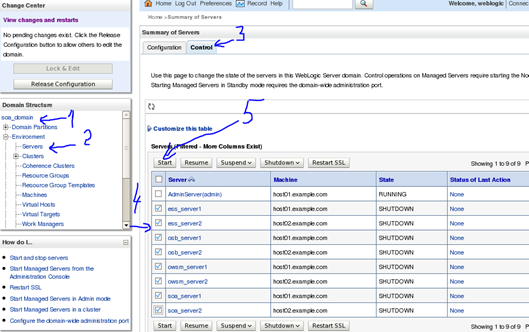
All Managed Servers are running:

Get your familiar with the new look of the Enterprise Manager:
Open the page: http://192.168.75.32:7001/em:
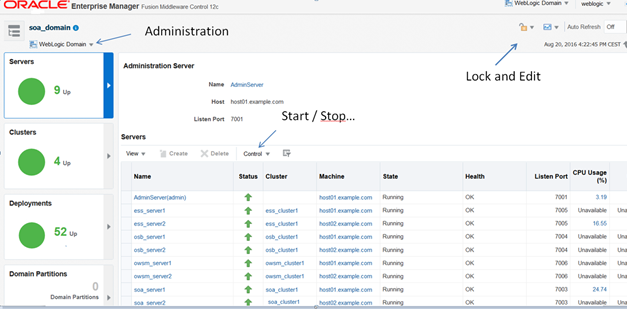
Prepare the WebLogic Server domain for the auto start
Server host01:
Create directory (as OS User oracle):
[oracle@host01 ~]$ mkdir /u01/app/oracle/scripts [oracle@host01 ~]$ chmod 744 /u01/app/oracle/scripts [oracle@host01 ~]$ cd /u01/app/oracle/scripts
Create scripts in the directory /u01/app/oracle/scripts (as OS User oracle)
Create script /home/oracle/scripts/fmw_nodemanager.sh:
#!/bin/bash
## fmw_nodemanager.sh
DOMAIN_HOME=/u01/app/oracle/user_projects/domains/soa_domain
WORK_DIR=/u01/app/oracle/scripts
export DOMAIN_HOME WORK_DIR
case "$1" in
start)
nohup ${DOMAIN_HOME}/bin/startNodeManager.sh > ${WORK_DIR}/nodemanager.out 2>&1 &
;;
stop)
${DOMAIN_HOME}/bin/stopNodeManager.sh
;;
*)
echo "usage: $0 [start|stop]"
exit 2
;;
esac
Create script /u01/app/oracle/scripts/fmw_admin_and_ms.sh:
#!/bin/bash
## fmw_admin_and_ms.sh
DOMAIN_HOME=/u01/app/oracle/user_projects/domains/soa_domain
ORACLE_HOME=/u01/app/oracle/product/FMW/Oracle_Home
WORK_DIR=/u01/app/oracle/scripts
export DOMAIN_HOME ORACLE_HOME WORK_DIR
WLST=${ORACLE_HOME}/oracle_common/common/bin/wlst.sh
export WLST
case "$1" in
start)
${WLST} ${WORK_DIR}/start_admin.py
${WLST} ${WORK_DIR}/start_ms.py
;;
start_admin)
${WLST} ${WORK_DIR}/start_admin.py
;;
start_ms)
${WLST} ${WORK_DIR}/start_ms.py
;;
stop)
${WLST} ${WORK_DIR}/stop_ms.py
${WLST} ${WORK_DIR}/stop_admin.py
;;
stop_admin)
${WLST} ${WORK_DIR}/stop_admin.py
;;
stop_ms)
${WLST} ${WORK_DIR}/stop_ms.py
;;
*)
echo "usage: $0 [start|start_admin|start_ms|stop|stop_admin|stop_ms]"
exit 2
;;
esac
Create script /u01/app/oracle/scripts/start_admin.py:
nmConnect('nodemanager','welcome1, '192.168.75.32','5556','base_domain','/u01/app/oracle/user_projects/domains/soa_domain')
nmStart('AdminServer')
Create script /u01/app/oracle/scripts/stop_admin.py:
nmConnect('nodemanager','welcome1, '192.168.75.32','5556','base_domain','/u01/app/oracle/user_projects/domains/soa_domain')
nmKill('AdminServer')
Create script /u01/app/oracle/scripts/start_ms.py:
nmConnect('nodemanager','welcome1, '192.168.75.32','5556','base_domain','/u01/app/oracle/user_projects/domains/soa_domain')
nmStart('owsm_server1')
nmStart('osb_server1')
nmStart('soa_server1')
nmStart('ess_server1')
Create script /u01/oracle/scripts/stop_ms.py:
nmConnect('nodemanager','welcome1, '192.168.75.32','5556','base_domain','/u01/app/oracle/user_projects/domains/soa_domain')
nmKill('ess_server1')
nmKill('soa_server1')
nmKill('osb_server1')
nmKill('owsm_server1')
Set permissions:
[oracle@host01 scripts]$ chmod -R 747 /u01/app/oracle/scripts
Integrate start-stop-scripts in Linux run-level (as OS user root)
Create script /etc/init.d/oracle (as root):
#!/bin/sh
# chkconfig: 345 99 10
# description: Oracle auto start-stop script.
# Set ORA_OWNER to the user id of the owner of the
export HOME=/u01/app/oracle/scripts
ORA_OWNER=oracle
if [ ! -f ${HOME}/fmw_nodemanager.sh \
-o ! -f ${HOME}/fmw_admin_and_ms.sh \
-o ! -f ${HOME}/start_admin.py \
-o ! -f ${HOME}/stop_admin.py \
-o ! -f ${HOME}/start_ms.py \
-o ! -f ${HOME}/stop_ms.py ]
then
echo "Oracle FMW startup: cannot start"
exit
fi
case "$1" in
'start')
su $ORA_OWNER -c "$HOME/fmw_nodemanager.sh start"
sleep 120
su $ORA_OWNER -c "$HOME/fmw_admin_and_ms.sh start"
;;
'stop')
su $ORA_OWNER -c "${HOME}/fmw_admin_and_ms.sh stop"
su $ORA_OWNER -c "${HOME}/fmw_nodemanager.sh stop"
;;
esac
Integrate the script /etc/init.d/oracle in run-levels (as root):
[root@host01 init.d]# chmod 700 /etc/init.d/oracle [root@host01 init.d]# cd /etc/init.d [root@host01 init.d]# chkconfig --add oracle
Check ( as root):
[root@host01 init.d]# chkconfig --list oracle oracle 0:off 1:off 2:off 3:on 4:on 5:on 6:off
Server soa02
Create directory (as OS User oracle):
[oracle@host02 ~]$ mkdir /u01/app/oracle/scripts [oracle@host02 ~]$ chmod 744 /u01/app/oracle/scripts [oracle@host02 ~]$ cd /u01/app/oracle/scripts
Create scripts in the directory /u01/app/oracle/scripts (as OS User oracle)
Create script /u01/app/oracle/scripts/fmw_nodemanager.sh:
#!/bin/bash
## fmw_nodemanager.sh
DOMAIN_HOME=/u01/app/oracle/user_projects/domains/soa_domain
WORK_DIR=/u01/app/oracle/scripts
export DOMAIN_HOME WORK_DIR
case "$1" in
start)
nohup ${DOMAIN_HOME}/bin/startNodeManager.sh > ${WORK_DIR}/nodemanager.out 2>&1 &
;;
stop)
${DOMAIN_HOME}/bin/stopNodeManager.sh
;;
*)
echo "usage: $0 [start|stop]"
exit 2
;;
esac
Create script /u01/app/oracle/scripts/fmw_ms.sh:
#!/bin/bash
## fmw_ms.sh
DOMAIN_HOME=/u01/app/oracle/user_projects/domains/soa_domain
ORACLE_HOME=/u01/app/oracle/product/FMW/Oracle_Home
WORK_DIR=/u01/app/oracle/scripts
export DOMAIN_HOME ORACLE_HOME WORK_DIR
WLST=${ORACLE_HOME}/oracle_common/common/bin/wlst.sh
export WLST
case "$1" in
start)
${WLST} ${WORK_DIR}/start_ms.py
;;
stop)
${WLST} ${WORK_DIR}/stop_ms.py
;;
*)
echo "usage: $0 [start|stop]"
exit 2
;;
esac
Create script /u01/app/oracle/scripts/start_ms.py:
nmConnect('nodemanager','welcome1, '192.168.75.33','5556','base_domain','/u01/app/oracle/user_projects/domains/soa_domain')
nmStart('owsm_server2')
nmStart('osb_server2)
nmStart('soa_server2')
nmStart('ess_server2')
Create script /u01/app/oracle/scripts/stop_ms.py:
nmConnect('nodemanager','welcome1, '192.168.75.33','5556','base_domain','/u01/app/oracle/user_projects/domains/soa_domain')
nmKill('ess_server2')
nmKill('soa_server2')
nmKill('osb_server2')
nmKill('owsm_server2')
Set permissions:
[oracle@host02 scripts]$ chmod -R 747 /home/oracle/scripts
Integrate start-stop-scripts in Linux run-level (as OS user root)
Create script /etc/init.d/oracle (as root):
#!/bin/sh
# chkconfig: 345 99 10
# description: Oracle auto start-stop script.
# Set ORA_OWNER to the user id of the owner of the
export HOME=/u01/app/oracle/scripts
ORA_OWNER=oracle
if [ ! -f ${HOME}/fmw_nodemanager.sh \
-o ! -f ${HOME}/fmw_ms.sh \
-o ! -f ${HOME}/start_ms.py \
-o ! -f ${HOME}/stop_ms.py ]
then
echo "Oracle FMW startup: cannot start"
exit
fi
case "$1" in
'start')
su $ORA_OWNER -c "$HOME/fmw_nodemanager.sh start"
sleep 120
su $ORA_OWNER -c "$HOME/fmw_ms.sh start"
;;
'stop')
su $ORA_OWNER -c "${HOME}/fmw_ms.sh stop"
su $ORA_OWNER -c "${HOME}/fmw_nodemanager.sh stop"
;;
esac
Integrate the script /etc/init.d/oracle in run-levels (as root):
[root@host02 init.d]# chmod 700 /etc/init.d/oracle [root@host02 init.d]# cd /etc/init.d [root@host02 init.d]# chkconfig --add oracle
Check (as root):
[root@host02 init.d]# chkconfig --list oracle oracle 0:off 1:off 2:off 3:on 4:on 5:on 6:off
Tuning and Troubleshooting the SOA Domain
Tuning JVM (as OS User oracle)
We will customize the settings for the Java Heap size and for WebLogic Server Start parameters by the creating the File setUserOverrrides.sh.
We will tune the Java heap size for the Admin Server and for each Managed Server.
We will set some WebLogic Server start Parameter:
- -Dweblogic.MaxMessageSize=300000000 # increase the MessageSize
- -Dweblogic.threadpool.MinPoolSize=1024 # Tuning the WebLogic ThreadPool
For more information about the customizing of Java settings please refer to my article https://borysneselovskyi.wordpress.com/2016/07/24/how-to-customize-java-virtual-machine-settings-in-oracle-weblogic-server-12-on-os-linux-unix
Creating the File setUserOverrides.sh on both hosts: host01.example.com and host02.example.com:
[oracle@host01 ~]$ cd /u01/app/oracle/user_projects/domains/soa_domain/bin [oracle@host01 bin]$ cat setUserOverrides.sh
Content of setUserOverrides.sh:
#!/bin/bash
echo "Setting from UserOverrides.sh"
# global settinga (for all servers)s
export JAVA_OPTIONS="$JAVA_OPTIONS -Dweblogic.MaxMessageSize=300000000 -Dweblogic.threadpool.MinPoolSize=1024"
# customer settings for each server
if [ "${SERVER_NAME}" = "AdminServer" ]
then
echo "Customizing USER_MEM_ARGS for SERVER_NAME ${SERVER_NAME}"
export USER_MEM_ARGS="-Xms512m -Xmx1g"
fi
if [ "${SERVER_NAME}" = "soa_server1" ]
then
echo "Customizing USER_MEM_ARGS for SERVER_NAME ${SERVER_NAME}"
export USER_MEM_ARGS="-Xms1g -Xmx2g -XX:+UseParNewGC -XX:+UseConcMarkSweepGC -XX:NewSize=1g"
echo "Customizing JAVA_OPTIONS for SERVER_NAME ${SERVER_NAME}"
export JAVA_OPTIONS="$JAVA_OPTIONS -Djava.awt.headless=true"
# Coherence Settings
export JAVA_OPTIONS="${JAVA_OPTIONS} -Dtangosol.coherence.localhost=192.168.75.32"
export JAVA_OPTIONS="${JAVA_OPTIONS} -Dtangosol.coherence.wka1=192.168.75.32 -Dtangosol.coherence.wka2=192.168.75.33"
export JAVA_OPTIONS="${JAVA_OPTIONS} -Dtangosol.coherence.localport=8090"
export JAVA_OPTIONS="${JAVA_OPTIONS} -Dtangosol.coherence.localport.adjust=true"
fi
if [ "${SERVER_NAME}" = "soa_server2" ]
then
echo "Customizing USER_MEM_ARGS for SERVER_NAME ${SERVER_NAME}"
export USER_MEM_ARGS="-Xms1g -Xmx2g -XX:+UseParNewGC -XX:+UseConcMarkSweepGC -XX:NewSize=1g"
echo "Customizing JAVA_OPTIONS for SERVER_NAME ${SERVER_NAME}"
export JAVA_OPTIONS="$JAVA_OPTIONS -Djava.awt.headless=true"
# Coherence Settings
export JAVA_OPTIONS="${JAVA_OPTIONS} -Dtangosol.coherence.localhost=192.168.75.33"
export JAVA_OPTIONS="${JAVA_OPTIONS} -Dtangosol.coherence.wka1=192.168.75.33 -Dtangosol.coherence.wka2=192.168.75.32"
export JAVA_OPTIONS="${JAVA_OPTIONS} -Dtangosol.coherence.localport=8090"
export JAVA_OPTIONS="${JAVA_OPTIONS} -Dtangosol.coherence.localport.adjust=true"
fi
if [ "${SERVER_NAME}" = "osb_server1" -o "${SERVER_NAME}" = "osb_server2" ]
then
echo "Customizing USER_MEM_ARGS for SERVER_NAME ${SERVER_NAME}"
export USER_MEM_ARGS="-Xms1g -Xmx2g -XX:+UseParNewGC -XX:+UseConcMarkSweepGC -XX:NewSize=1g"
echo "Customizing JAVA_OPTIONS for SERVER_NAME ${SERVER_NAME}"
export JAVA_OPTIONS="$JAVA_OPTIONS -Djava.awt.headless=true"
fi
if [ "${SERVER_NAME}" = "owsm_server1" -o "${SERVER_NAME}" = "owsm_server2" ]
then
echo "Customizing USER_MEM_ARGS for SERVER_NAME ${SERVER_NAME}"
export USER_MEM_ARGS="-Xms512m -Xmx1g -XX:+UseParNewGC -XX:+UseConcMarkSweepGC -XX:NewSize=512m"
echo "Customizing JAVA_OPTIONS for SERVER_NAME ${SERVER_NAME}"
export JAVA_OPTIONS="$JAVA_OPTIONS -Djava.awt.headless=true"
fi
if [ "${SERVER_NAME}" = "ess_server1" -o "${SERVER_NAME}" = "ess_server2" ]
then
echo "Customizing USER_MEM_ARGS for SERVER_NAME ${SERVER_NAME}"
export USER_MEM_ARGS="-Xms512m -Xmx1g -XX:+UseParNewGC -XX:+UseConcMarkSweepGC -XX:NewSize=512m"
echo "Customizing JAVA_OPTIONS for SERVER_NAME ${SERVER_NAME}"
export JAVA_OPTIONS="$JAVA_OPTIONS -Djava.awt.headless=true"
fi
echo "End setting from UserOverrides.sh"
Tuning Fusion Middleware Control (as OS User oracle)
Reference: MOS Note „How to Enable Discovery Cache To Avoid Long Delay During Login To Fusion Middleware Control (Doc ID 1423893.1)“
On the server host01 login to wlst with weblogic user and connect to domain environment:
[oracle@host01 ~]$ /u01/app/oracle/product/FMW/Oracle_Home/oracle_common/common/bin/wlst.sh
Connect to the AdminServer:
wls:/offline> connect('weblogic','welcome1','t3://192.168.75.32:7001')
Change location to domain custom tree
wls:/base_domain/serverConfig/> domainCustom()
Set variables:
wls:/soa_domain/domainCustom/> myMBean=ObjectName('emoms.props:Location=AdminServer,name=emoms.properties,type=Properties,Application=em')
wls:/soa_domain/domainCustom/> types=['java.lang.String', 'java.lang.String']
wls:/soa_domain/domainCustom/> type=['java.lang.String']
Set property oracle.sysman.emas.discovery.wls.FMW_DISCOVERY_USE_CACHED_RESULTS=true:
wls:/soa_domain/domainCustom/> params=['oracle.sysman.emas.discovery.wls.FMW_DISCOVERY_USE_CACHED_RESULTS', 'true'] wls:/soa_domain/domainCustom/> mbs.invoke(myMBean,'setProperty',params,types)
Set property oracle.sysman.emas.discovery.wls.FMW_DISCOVERY_MAX_CACHE_AGE=7200000:
wls:/soa_domain/domainCustom/> params=['oracle.sysman.emas.discovery.wls.FMW_DISCOVERY_MAX_CACHE_AGE','7200000'] wls:/soa_domain/domainCustom/> mbs.invoke(myMBean,'setProperty',params,types)
Set property oracle.sysman.emas.discovery.wls.FMW_DISCOVERY_MAX_WAIT_TIME=10000:
wls:/soa_domain/domainCustom/> params=['oracle.sysman.emas.discovery.wls.FMW_DISCOVERY_MAX_WAIT_TIME','10000'] wls:/soa_domain/domainCustom/> mbs.invoke(myMBean,'setProperty',params,types)
Invoke getProperty operations to display and confirm parameter values (Values returned by wlst are in red):
Display changes added:
wls:/soa_domain/domainCustom/> param=['oracle.sysman.emas.discovery.wls.FMW_DISCOVERY_USE_CACHED_RESULTS'] wls:/soa_domain/domainCustom/> mbs.invoke(myMBean,'getProperty',param,type) 'true' wls:/soa_domain/domainCustom/> param=['oracle.sysman.emas.discovery.wls.FMW_DISCOVERY_MAX_CACHE_AGE'] wls:/soa_domain/domainCustom/> mbs.invoke(myMBean,'getProperty',param,type) '7200000' wls:/soa_domain/domainCustom/> param=['oracle.sysman.emas.discovery.wls.FMW_DISCOVERY_MAX_WAIT_TIME'] wls:/soa_domain/domainCustom/> mbs.invoke(myMBean,'getProperty',param,type) '10000'
Tuning the WebLogic Server Start: Avoiding JVM Delays Caused by Random Number Generation
Change the JVM random generation from /dev/random to /dev/urandom. For more Information refer to the Oracle Documentation:
https://docs.oracle.com/cd/E13209_01/wlcp/wlss30/configwlss/jvmrand.html
Go to the file java.security and change the parameter securerandom.source:
Server host01 (as OS User oracle):
[oracle@host01 ~]$ vi /u01/app/oracle/product/JAVA/jdk/jre/lib/security/java.security
Old value:
securerandom.source=file:/dev/random
Change to:
securerandom.source=file:/dev/urandom
Repeat the step on the Server host02.example.com.
Restart the Admin and all Managed Servers.
Configure the SOA Purging via Enterprise Manager Fusion Middleware Control
Go to Fusion Middleware Control
Navigate to SOA -> soa-infra:
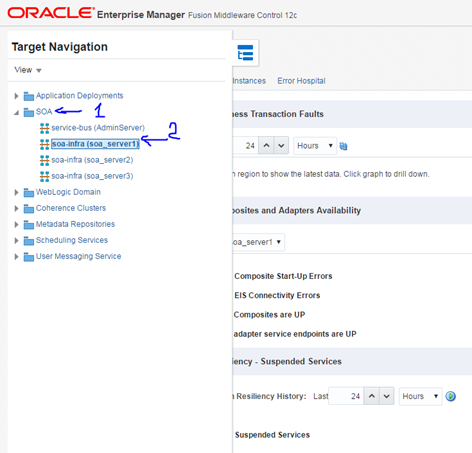
Then to SOA Infrastructure -> SOA Administration -> Auto Purge:
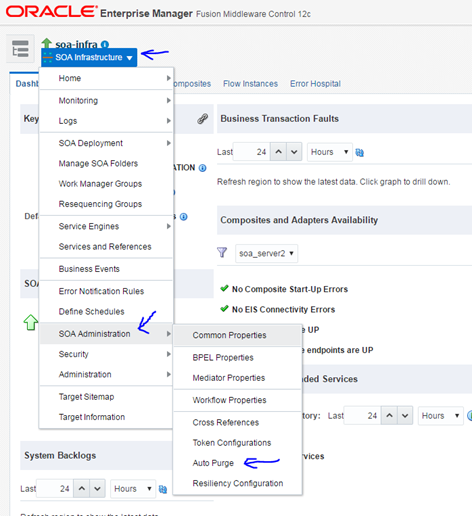
The Purge Configuration Page appears. You can set the scheduling options, Type of Purge (single or parallel) and another settings:
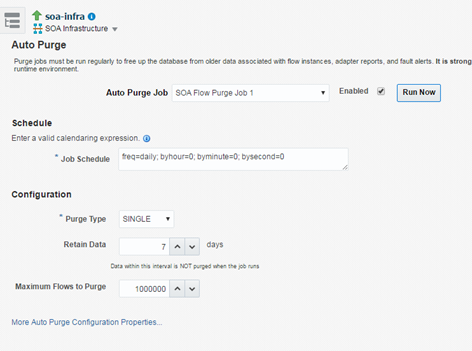
enjoy 🙂





13 Kommentare
Pingback: SOA & BPM Community Newsletter September 2016 | SOA Community Blog
Pingback: SOA Suite 12.2.1.1.0: Create, configure and tune a SOA/OSB Domain by Neselovskyi, Borys | SOA Community Blog
Sehr gut artikel 🙂
Pingback: SOA Suite 12.2.1.1.0: Create, configure and tune a SOA/OSB Domain by Borys Neselovskyi - GIN Personal Web Site
Good article, I only disagree in only one fact depending on how much you will use dehydration and state transactions maybe is better use LARGE as the database profile when running RCU.
Doing it so will create the database partitioned and improve performance.
http://docs.oracle.com/middleware/1213/core/INSOA/planning.htm#INSOA524
Thanks for your response. In the blog entry I described the basic installation/configuration.
The topics like performance / security and high availability are very extensive. Maybe I’ll write about it later
Great topic
now soa got two links one for each machine right ?
if i want to make it one url i must use load blander !
yes, it is the best practice to use a loadbalancer with the clustered soa environment
Muito bom, obrigado por compartilhar seu conhecimento
great installation steps and well organized. once i’m trying to reach each node separately I’m receiving error 404
http://node1:7003/servicebus
http://node2:7003/servicebus
but it’s working fine for http://node1:7001/servicebus
please need your support
Hi Kamal, for the default installation you need use the following url for the accesing the OSB: http://:host:port/sbconsole
Neselovskyi, Borys I hope this is well:
By chance you have had this error:
Error in SOA Suite 12.2.1.4:
During deployment to an SOA cluster. When deployed to SOA node1, the deployment is removed from node 1 immediately (it is aborted) and only node 2 remains.
Hi Jose,
I’m replying on behalf of Borys, who hasn’t been with us for a while. I have spoken to the colleagues who are familiar with this issue and we are not aware of it. Please describe the case in more detail, or if your company is located in Germany and you need larger-scale support, please feel free to contact us via our contact form at http://www.opitz-consulting.com
Best Regards
Nathalie